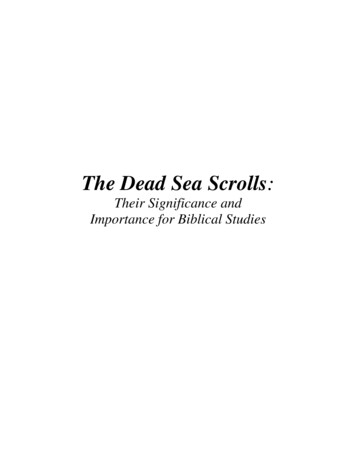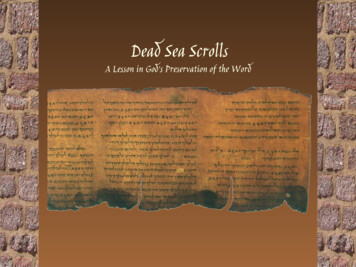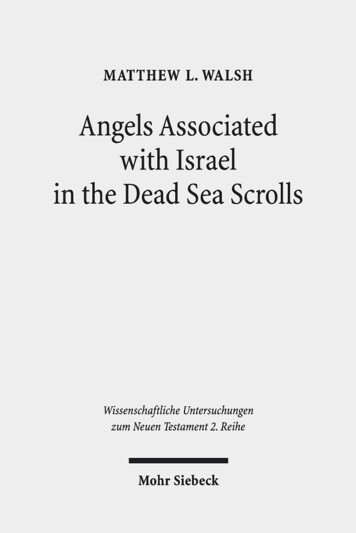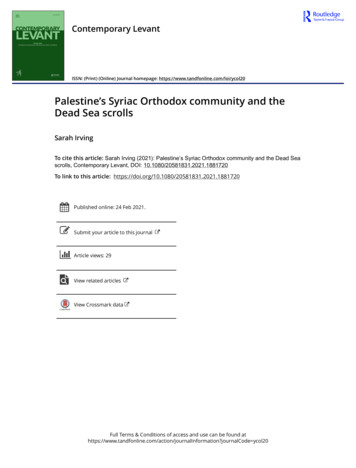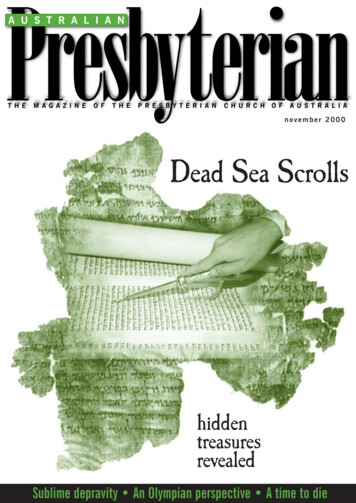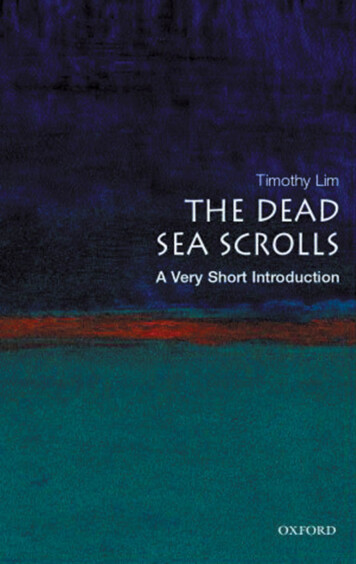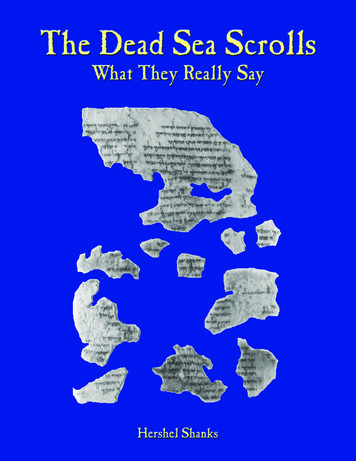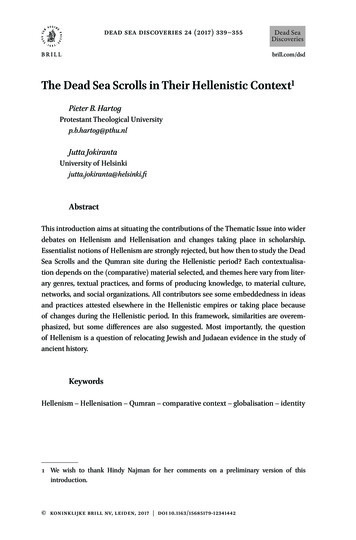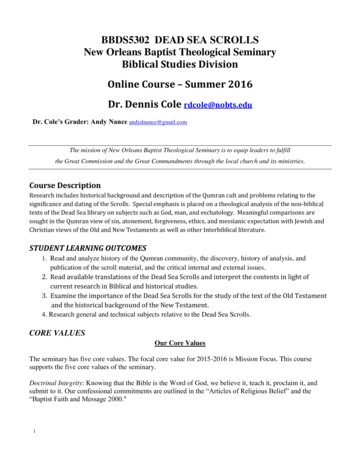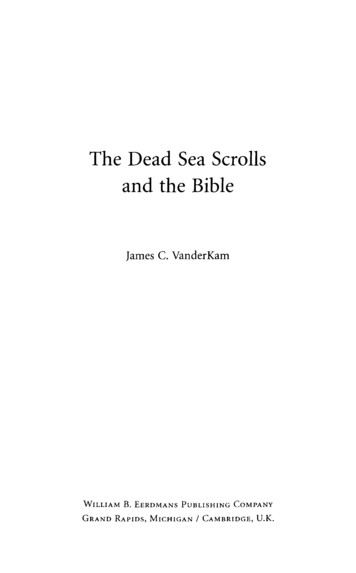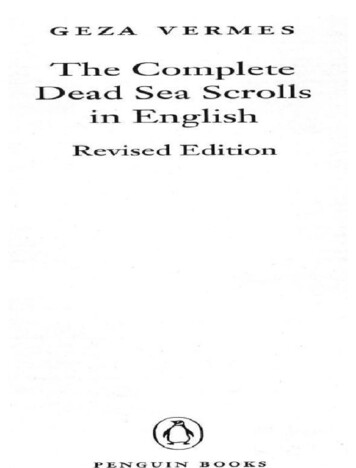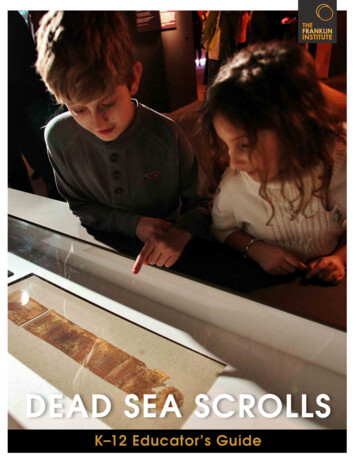
Transcription
DEAD SEA SCROLLSK–12 Educator’s Guide
DEADSEASCROLLSLIFE AND FAITH INANCIENT TIMESIn partnership with:
What are the Dead Sea Scrolls?Where were they found?Why are they important?The Dead Sea Scrolls exhibit invites you andyour students to consider these questions andthe impact of the Scrolls on our world today.QUICK TIPS An optional audio tour is available for anadditional charge. The exhibit exits into a gift shop where you will finda variety of items related to the special exhibition. On average, most groups will spend about 60minutes in the exhibit, if carefully examining all of theartifacts. There is no reentry allowed. Restrooms arelocated near the exhibit entrance and exit, but thereare no restrooms inside the exhibit. No photography is allowed inside the exhibit. Novideo or audio recording devices of any kind areallowed. Mobile phones and devices must be turnedoff in the galleries. No food or beverages are allowed.During your visit to Dead Sea Scrolls: Lifeand Faith in Ancient Times, students will: Go on a journey back in time. See a collection of more than 600artifacts. Explore a culture that is unlike our own,yet inspired much of how we live today.After your visit to Dead Sea Scrolls: Lifeand Faith in Ancient Times, students will: Reflect on the meaning of the Scrolls. Think about how other people lived inother times. Understand that all people sharecommon bonds, even if we choose tolive our lives in different ways.
ABOUT THE EXHIBITThe Dead Sea Scrolls: Life and Faith in Ancient Times exhibit presents one of the mostcomprehensive collections of ancient artifacts from Israel ever organized, featuringtwenty scrolls including the oldest known copies of the Hebrew Bible and four neverbefore-seen scrolls. With more than 600 items on display, visitors will experiencefirsthand the traditions and beliefs of everyday life, as lived more than 2000 yearsago. These fascinating artifacts, such as an actual three-ton stone from Jerusalem’sWestern Wall, highlight the millennia-old traditions that continue to impact modernreligions and society today. Included among the collection’s artifacts are thelimestone capitals used in the architecture of the administrative centers during thefirst temple period (1006-586 BCE). Students will see artifacts from Jerusalem’s Cityof David, limestone Ossuaries from the early Roman period, and an ancient signaturepreserved for millennia on the Archer Seal. Together these artifacts reveal preciousdetails about the culture, rituals, and beliefs of ancient Israel.HOW TO PREPAREStudents should know that this is an extremely rare opportunity to see the objectson display. The artifacts that they will see are considered sacred to many people. Theexhibit should be approached seriously and respectfully.The information in this guide will help orient students and prepare them for theexperience. Encourage your students to read the age-appropriate suggested booksfrom the list included here. These books will acquaint your students with the DeadSea Scrolls and the culture of ancient times.WHAT ARE THE DEAD SEA SCROLLS?The Dead Sea Scrolls are a collection of 972 documents found between 1947 and 1956 in cavesnear the Dead Sea. Many of the scrolls are copies of texts from the Hebrew Bible. The texts are writtenin Hebrew, Aramaic, and Greek. Most are on animal skins, with some on papyrus or parchment.Modern carbon-14 dating has shown that they were written between 120 BCE and 68 CE.Nobody is quite sure why, but in 1947 young goat-herders wandered inside a cave, perhaps insearch of a stray goat, shade from the sun, or even hidden treasure. Whatever the reason, theymade a remarkable discovery. They found an assortment of clay jars, inside of which were leatherscrolls, wrapped in linen. Over the next nine years, archaeologists searched the surrounding caves,eventually assembling the full collection of documents that we know today as the Dead SeaScrolls. They have been called the most significant archaeological find of the last century.
WHAT TO EXPECTDead Sea Scrolls: Life and Faith in Ancient Times is an exhibition of recoveredartifacts, enclosed in display cases. The displays in the exhibit are “hands-off,” as theobjects are far too rare and fragile to be touched. The exhibition is organized intosections, each of which is highlighted below.All dates in the exhibit are presented using the international calendar conventionof the Common Era (CE) which began with the year 1. Earlier history is expressed asBefore the Common Era (BCE). Students may be more familiar with the conventions ofBC and AD. The BCE and CE system is independent of religious belief and, therefore,more consistently used in scientific and academic presentations.GENESIS GALLERYThe exhibit begins with this scriptural passage, setting the scene for theexhibit: “The Lord said to Abram, ‘Go forth from your native land and fromyour father’s house to the land that I will show you.’” Genesis 12:1.DESERT ORIENTATION THEATERYou will be transported to the shores of the Dead Sea, where the scene isset for your journey back in time.BACK TO THE PAST: TIMELINE GALLERYFrom the present, we trace the history of Israel back to ancient times.Graphic panels, artifacts, and objects illustrate the story along the way.Finally, we reach the time of the Early Israelites, known as the Iron Age.THE SCROLL GALLERYThree faiths—Christianity, Judaism, and Islam—share common faith in thetexts of the Dead Sea Scrolls. It is in the Scroll Gallery that we see thecommon roots. The Scrolls Table is the centerpiece and highlight. Thestone from Jerusalem’s Western Wall is also found here.BIBLICAL GALLERYHere, we are immersed in the culture of the Early Israelites including avisit to a four-room house and an exploration of the objects of everydaylife. It is at this time that nation-building also began and we see artifactsof national identity including monuments and fortresses. The importanceof faith and religious practice is also evident in the temple artifacts, altars,and presentation of biblical music.EPILOGUE GALLERYWe return to present day, left to reflect upon the significance of theScrolls in our modern world. “Stay in this land for a while, and I will bewith you and will bless you. . . . I will make your descendants as numerousas the stars in the sky and will give them all these lands, and through youroffspring all nations on earth will be blessed.” Genesis 26:3–5.
Dead Sea Scrolls:Life and Faith in Ancient TimesEXHIBIT QUEST!NameThe answers to these questions are waiting to be discovered.Look closely at the objects in the exhibit to find them.Your Quest! begins in the TIMELINE GALLERY.1. When did the modern state of Israel declare independence?2. When was the early Islamic period?3. When was the time of the Early Israelites?In the Biblical Gallery, find the HOUSEHOLD ACTIVITIES section.4. What did the Israelites use to weave wool?5. The average Israelite’s diet included four foods. Name them.Look for the BELONGING TO THE KING panel.6. On many objects in the exhibit, you will see a four letter abbreviation that means“belonging to the king” in Hebrew. What is that abbreviation?Look for the SCALES AND WEIGHTS panel.7. What word was used to measure a weight of 11.4 grams?In the Scroll Gallery, find the BONE GATHERING panel.8. Limestone boxes were used to hold the bones of deceased people.What were these boxes called?Look for the WHO WROTE THE DEAD SEA SCROLLS panel.9. Scholars are sure that they know who wrote the scrolls.TRUE orFALSEFind the large round SCROLL TABLE.10. Name any one of the scrolls on display.Find the STONE FROM THE WESTERN WALL panel.11. The stone on display is from the ruins of the Second Temple of Jerusalem.In what year was the temple destroyed?Look for the DISCOVERY THEATER.12.In what year were the Dead Sea Scrolls found in a cave by a goat-herder?
TRY THIS!Where in the World?Prepare for your visit to Dead Sea Scrolls: Life and Faith in Ancient Times by orienting students to thegeography of the Middle East. Use Google Maps to look at the region.1. Go to maps.google.com2. Enter “The Dead Sea” in the search box.3. Use the map’s view controllers to switch between satelliteand map views, comparing the features of each.4. Also, zoom in and out to show the outlines of the Dead Seaand the region.5. Notice the topographical features of the map and howelevation levels are presented.6. Locate Kalya, which, today, is the closest settlement tothe site of the caves where the Scrolls were found. Kalya isalong the Western shore of the Dead Sea, near its top.7. Locate Jerusalem, which is West of Kalya.DISCUSSION QUESTIONSHow far, approximately, is Kalya from Jerusalem?Why might someone have chosen to hide the Scrolls there?Do you think hiding the Scrolls in a cave by the Dead Sea wasa good idea? Explain your answer.
TRY THIS!PAPERMAKING!Today, you can go to the store to buy paper when you want to preserve important information. Two thousandyears ago, you would have needed to make papyrus or parchment before you could even begin to writeyour stories. Try making paper yourself. You just may realize how much more valuable every piece seems.MATERIALS Paper Pulp (see below) Blender Deckle Frame (see below) Sponge 2 Wash Basins Rolling Pin Small Towels IronTO DO:Make the Paper Pulp:Fill one wash basin about halfway with warm water. Tear scrap paper into small pieces, approximatelyone-inch square, and add to the water. Construction paper, tissue paper, and paper towels work well. Keepadding paper until the water level is near the top. You should have a soupy mix. Let the paper sit overnight.Make the Deckle Frame:A deckle frame is the mold for the paper. The best option is a wooden frame with a wire screen stapled toit. You can also use an aluminum pan as the frame; cut out the bottom of it and then staple a wire screen tocover the opening. Another option is to shape a wire hanger into a rectangle; then, cut open nylon stockingand wrap it around the wire frame, stapling it into place. You could also use an embroidery hoop with nylonstocking tightened into it. Whichever frame you make, be sure that it is smaller than the size of your washbasin.Make Paper:Lay small towels beside the second, empty wash basin. Fill the blender about halfway with warm water. Adda heaping handful of your pulp. Blend slowly until you can no longer see individual pieces of paper. Emptythe blender into the basin. Add more warm water to the basin and mix it thoroughly.Submerge your frame into the mixture. Move it back and forth to get an even layer of pulp on the screen.Lift the frame up and let it drain. Use your hands to push more water through the screen. Keep patting ituntil it stops dripping. Use your sponge to wipe the bottom of the screen.Flip your frame onto a towel and lift it gently away, leaving your paper sheet on the towel. Place anothertowel on top of it and gently apply pressure with the rolling pin to squeeze out the extra moisture. Leavethe paper between the towels and let everything dry overnight.To finish the paper, use your iron to flatten and smooth the sheet. Set the iron for dry pressing (no steam!)at a medium heat. Apply the iron to both the top and bottom towels, pressing it from top and then bottom.(Do not iron the paper directly!) Finally, pull the top towel gently away from the paper sheet and thencarefully lift the sheet of paper away from the bottom towel.Notes:These instructions should enable you to make several sheets of paper. You will need two towels for eachsheet you plan to make. Flat cotton dish towels work best. Avoid plush terry towels. If you have extra pulpleft over, you can freeze it for later use! If you don’t want to freeze extra pulp, put it out in the trash.Do NOT put it down your drain or garbage disposal.
DEAD SEA SCROLLS: LIFE AND FAITH IN ANCIENT TIMESSUGGESTED BOOKS FOR K-12 CLASSROOMS AND LIBRARIESELEMENTARY SCHOOLThe Mystery of the Dead Sea Scrollsby Hagit Allon ISBN 0827608004The Dead Sea: The Saltiest Seaby Aileen Weintraub ISBN 0823956377Daily Life at the Time of Jesusby Miriam Vamosh ISBN 0687048915Qumran Caves: Hiding Place for the Dead Sea Scrollsby Brad Burnham ISBN 0823962598MIDDLE SCHOOLWith a Little Luck: Surprising Stories of Amazing Discoveriesby Dennis B. Fradin ISBN 0525471960Walking the Bible: An Illustrated Journey for KidsThrough the Greatest Stories Ever Toldby Bruce Feiler ISBN 0060511184HIGH SCHOOLThe Complete Dead Sea Scrolls in English: Seventh Editionby Geza Vermes ISBN 0141197315The Meaning of the Dead Sea Scrolls: Their SignificanceFor Understanding the Bible, Judaism, Jesus, and Christianityby James VanderKam and Peter Flint ISBN 0060684658The Archaeology of Qumran and the Dead Sea Scrollsby Jodi Magness ISBN 0802826873The Complete World of the Dead Sea Scrollsby Philip R. Davies, George J. Brooke, and Phillip R. CallawayISBN 0500283710RECOMMENDED WEBSITESThe Digital Dead Sea Scrolls - dss.collections.imj.org.ilScrolls from the Dead Sea: The Ancient Library of Qumranand Modern Scholarship - www.loc.gov/exhibits/scrollsThe Qumran Visualization Project - www.virtualqumran.com
CURRICULAR STANDARDSWORLD HISTORY & SOCIAL STUDIES EDUCATIONAs one of the twentieth century’s most significant archaeological finds, the Dead Sea Scrolls are historicallyrelevant in both ancient and modern terms. The exhibit presents both the discovery of the scrolls as anhistorical event as well as the stories they tell as documentation of an ancient culture. A visit to the exhibit,therefore, can help you serve varied curricular objectives. The following presentation suggests alignmentswith both the National Standards for History and the Curriculum Standards for Social Studies.National Standards for HistoryWorld History – Grades 5-12Era 3 – Classical Traditions, Major Religions, and Giant Empires,1000 BCE-300 CESTANDARD 2 – The emergence of Aegean civilization andhow interrelations developed among peoples of the easternMediterranean and Southwest Asia, 600-200 BCE.STANDARD 3 – How major religions and large-scale empires arosein the Mediterranean basin, China, and India, 500 BCE-300 CE.Curriculum Standards for Social StudiesI. CultureSocial studies programs should include experiences that providefor the study of culture and cultural diversity.II. Time, Continuity, and ChangeSocial studies programs should include experiences that providefor the study of the ways human beings view themselves in andover time.III. People, Places, and EnvironmentsSocial studies programs should include experiences that providefor the study of people, places, and environments.VI. Power, Authority, and GovernanceSocial studies programs should include experiences that providefor the study of how people create and change structures ofpower, authority, and governance.
CURRICULAR STANDARDSSCIENCE EDUCATIONAs an artifact-based exhibit, Dead Sea Scrolls: Life and Faith in AncientTimes does not directly enable engagement with scientific content orphenomena. However, the collection of artifacts offers an opportunityfor students to consider how people from another culture arrangedtheir lives and attempted to make sense of their world. These practicesencourage critical-thinking and analysis, two skills which align withnational science standards.Next Generation Science StandardsK: Weather & Climate3: Weather & ClimateMS: Weather & ClimateHS: Weather & ClimateNational Science EducationStandardsK-4 G: History & Nature of Science5-8 G: History & Nature of Science9-12 G: History & Nature of ScienceBenchmarks for Science Literacy7. Human Society7a. Cultural Effects on Behavior
CURRICULAR STANDARDSOTHER STANDARDSCommon CoreEnglish Language ArtsCommon Core MathematicsK-12: Measurement & DataK-5: Reading Informational Text6-12: Literacy in Science & TechnicalSubjectsNational Standards for Arts EducationVisual ArtsContent Standard: 4:Understanding the visual arts inrelation to history and cultures.Content Standard: 5:Reflecting upon and assessingthe characteristics and meritsof their work and the work ofothers.Content Standard: 6:Making connections betweenvisual arts and other disciplines.Exhibit Quest! Answer Key:1. May 14, 1948.2. 638-1099CE.3. Iron Age I (1200-1000 BCE).4. grain, legumes, vegetables, meat5. looms with clay weights6. LMLK7. shekel8. ossuaries9. false10. Answers will vary depending onwhich are displayed during your visit.11. 70 CE12. 1947
An Educational Product ofTHE FRANKLIN INSTITUTEThe Franklin Institute222 North 20th StreetPhiladelphia, Pennsylvania 19103www.fi.edu
The Dead Sea Scrolls: Life and Faith in Ancient Times exhibit presents one of the most comprehensive collections of ancient artifacts from Israel ever organized, featuring twenty scrolls including the oldest known copies of the Hebrew Bible and four never-before-seen scrolls. With more than 600 items on display, visitors will experience
